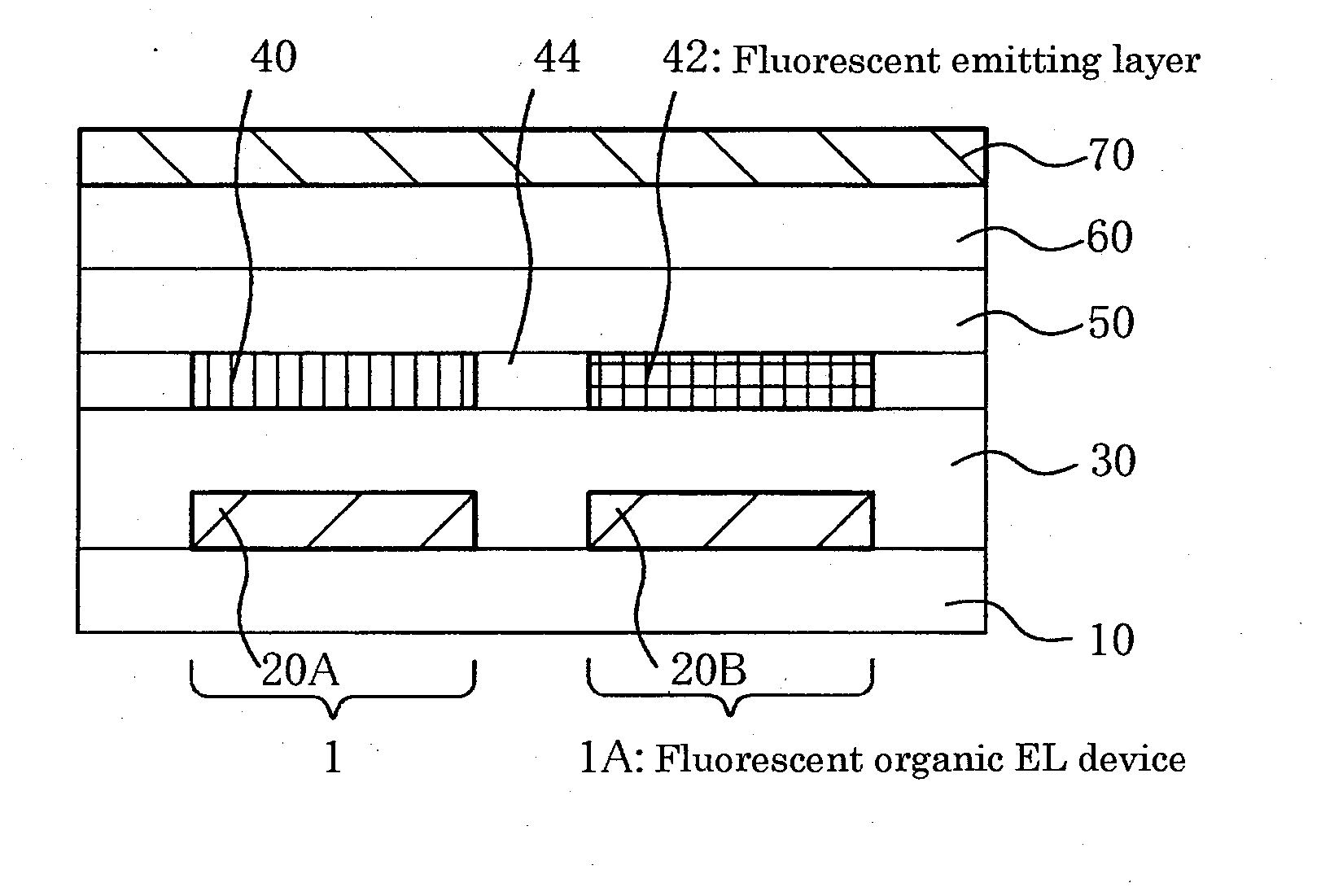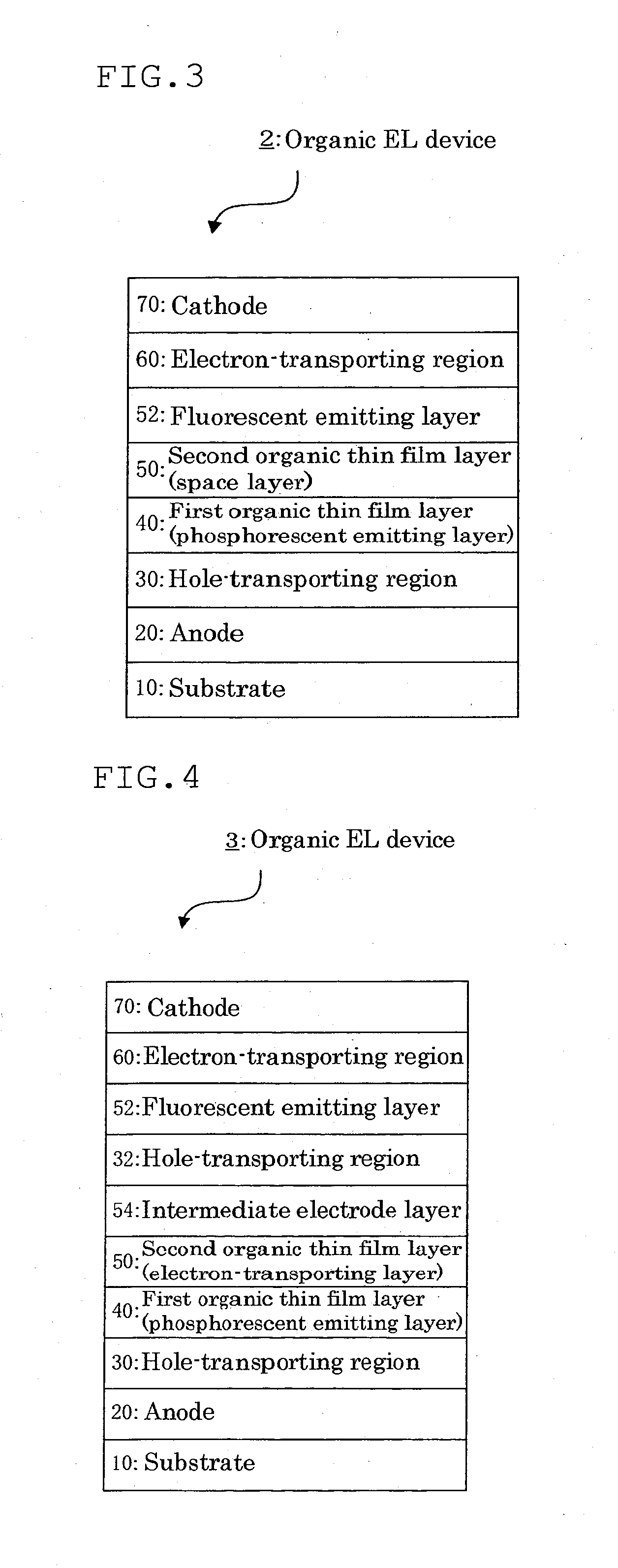Organic electroluminescence element
a technology of electroluminescence element and organic el, which is applied in the direction of luminescent composition, organic chemistry, chemistry apparatus and processes, etc., can solve the problems high efficiency of phosphorescent organic el device cannot be obtained by merely applying fluorescent device technology, and hydrocarbon-based compound is hardly selected, so as to achieve high luminous efficiency and long life
- Summary
- Abstract
- Description
- Claims
- Application Information
AI Technical Summary
Benefits of technology
Problems solved by technology
Method used
Image
Examples
embodiment 1
[0227]FIG. 1 is a schematic view showing the layer configuration of the organic EL device of the invention.
[0228]An organic EL device 1 has a configuration in which an anode 20, a hole-transporting region 30, a first organic thin film layer 40, a second organic thin film layer 50, an electron-transporting region 60 and a cathode 70 are stacked on a substrate 10 in this sequence. The hole-transporting region 30 means a hole-transporting layer, a hole-injecting layer or the like. Similarly, the electron-transporting region 60 means an electron-transporting layer or an electron-injecting layer or the like. They are not required to be formed. However, it is preferred that one or more of these layers be formed.
[0229]In the organic EL device 1, the first organic thin film layer 40 functions as a phosphorescent emitting layer, and the second organic thin film layer 50 functions as an electron-transporting layer and a hole-barrier layer.
[0230]When the first organic thin film layer 40 and th...
embodiment 2
[0239]FIG. 3 is a schematic cross-sectional view showing the layer configuration of an organic EL device according to another embodiment of the invention.
[0240]An organic EL device 2 is an example of a hybrid-type organic EL device in which a phosphorescent emitting layer and a fluorescent emitting layer are stacked.
[0241]The organic EL device 2 has the same configuration as that of the above-mentioned organic EL device 1, except that a fluorescent emitting layer 52 is formed between the second organic thin film layer 50 and the electron-transporting region 60. In the organic EL device 2, the first organic thin film layer 40 functions as a phosphorescent emitting layer and the second organic thin film layer 50 functions as a space layer. In a configuration in which the phosphorescent emitting layer and the fluorescent emitting layer are stacked, in order to prevent excitons formed in the phosphorescent emitting layer from being diffused to the fluorescent emitting layer, there is a ...
embodiment 3
[0243]FIG. 4 is a schematic cross-sectional view showing the layer configuration of an organic EL device according to another embodiment of the invention.
[0244]An organic EL device 3 is an example of a tandem-type organic EL device in which a phosphorescent emitting layer and a fluorescent emitting layer are stacked through an intermediate electrode.
[0245]The organic EL device 3 has a configuration in which the anode 20, the hole-transporting region 30, the first organic thin film layer 40, the second organic thin film layer 50, an intermediate electrode layer 54, a hole-transporting region 32, a fluorescent emitting layer 52, the electron-transporting region 60 and a cathode 70 are stacked in this sequence on the substrate 10. A region disposed between the anode 20 and the intermediate electrode layer 54 is a first emitting unit (phosphorescent emission) and a region disposed between the intermediate electrode layer 54 and the cathode 70 is a second emitting unit (phosphorescent em...
PUM
| Property | Measurement | Unit |
|---|---|---|
| ionization potential | aaaaa | aaaaa |
| ionization potential | aaaaa | aaaaa |
| triplet energy | aaaaa | aaaaa |
Abstract
Description
Claims
Application Information
 Login to View More
Login to View More - R&D
- Intellectual Property
- Life Sciences
- Materials
- Tech Scout
- Unparalleled Data Quality
- Higher Quality Content
- 60% Fewer Hallucinations
Browse by: Latest US Patents, China's latest patents, Technical Efficacy Thesaurus, Application Domain, Technology Topic, Popular Technical Reports.
© 2025 PatSnap. All rights reserved.Legal|Privacy policy|Modern Slavery Act Transparency Statement|Sitemap|About US| Contact US: help@patsnap.com



